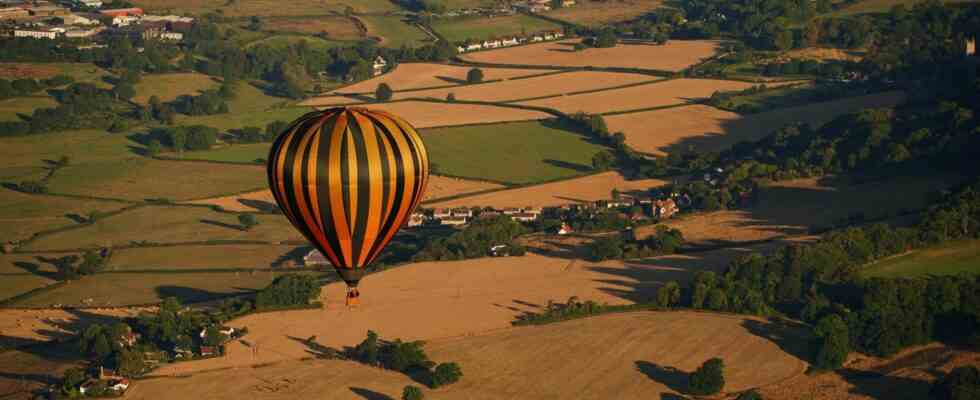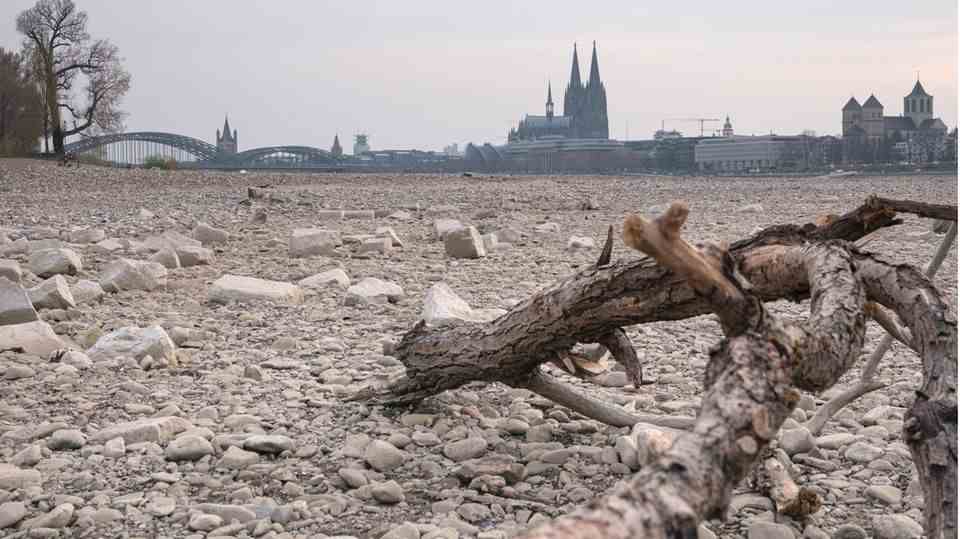heat wave
Drought in Great Britain: An island is dry
A balloon flies over fields brown and parched from the prolonged drought during the Bristol International Balloon Fiesta 2022
© Ben Birchall/PA Wire/DPA
Brown fields and dusty riverbeds: the drought has also reached Great Britain. Water is rationed in some regions. Other areas and measures could follow. The consequences are already dramatic.
Great Britain is naturally known for its rather damp and cool climate, its many rainy days and inhospitable wafts of fog. The sight that now presents itself is all the more surprising. Instead of lush green meadows and fields, numerous areas on the island shine in the most diverse shades of brown and yellow. A look at the Drought map from the UK Center for Ecology and Hydrology shows: The counties of Sussex, Essex, Kent and Thames in the south-east are particularly affected by severe to extreme drought. The same applies to some regions of Cornwall. The effects in the north are less dramatic, but even there only a few regions can be described as wet.
“We are experiencing a second heatwave after the driest July on record for parts of the country. Action is already being taken by the government and other partners, including the Environment Agency, to manage the impact,” Water Secretary Steve Double said after meeting with environmental officials and water companies. According to official information, Great Britain is currently experiencing the driest July since 1935. In addition, the months since November last year have been among the dryest since 1976. The last drought took place in 2018.
In the past few weeks and months, the situation has continued to deteriorate, like the UK Environment Agency weekly rainfall and flow report indicates. Already in early to mid-June it hardly rained on the entire island. The weather maps were already glowing red a month ago, now they are doing it again. That’s why representatives from the National Drought Group, the Environment Agency and water companies met with Minister Double on Friday morning to discuss the current situation. Result: Drought status has been declared for parts of the UK. 14 regions and counties in southern and central Britain are affected. Other regions are to follow in August, as the “Guardian” reports, citing leaked documents.
Drought dries up riverbeds and water reservoirs
For residents in the affected areas, this now means that water is rationed. Watering gardens, cleaning cars, using garden hoses or throwing on the lawn sprinkler are now prohibited. Even private swimming pools and paddling pools may no longer be filled. Around 1.4 million households will be affected by the ban, according to a BBC report. Excluded are, among other things, the commercial cultivation of plants, the irrigation of sports facilities and the operation of car washes.
The British Weather Service (MET) issued an extreme heat warning for the south-east of Great Britain and parts of Wales on Tuesday. It should not be withdrawn before Sunday. The maximum temperatures of over 30 degrees are expected for Friday and Saturday. With the issued weather warning, the authority warned the population, especially in Essex and Sussex, to save water. One of the reasons is the Hanningfield Reservoir. Where a year ago the blue shimmering expanse glittered in the sun, today there is a white sandy beach, green algae carpets and blue puddles. The pump storage reservoir, which actually holds up to 25,500 million liters, has shrunk to a minimum.

The water levels at the Hanningfield Reservoir in Essex for comparison: left from 05/28/2020 and right from 08/10/2022
© Nicholas.T.Ansell / Dominic Lipins / PA Wire / DPA
Tourists who want to hike in the south-western Cotswolds at the source of the Thames report similar things. “We started our holiday with a walk along the Thames. This morning we started at the source but we didn’t find the Thames”, reports Michael Sanders to the “Standard”. In the village of Ashton-Keenes, the river bed has completely dried up. What remains is brown, crumbling river bottom, over which insects circle.
Drought jeopardizes supply
This has consequences for the food supply. Half of the potato harvest could fall victim to drought because the fields cannot be irrigated. Even corn, which is more resistant to drought, will suffer damage this year. Because reservoirs across the country are emptying rapidly, losses of between 10 and 50 percent are expected for crops such as carrots, onions, sugar beets, apples and hops. Forest fires also endanger large areas of farmland. And even milk production could become scarce, because there is hardly enough feed for the cows.
Should the situation deteriorate further, water suppliers could ask the British government for a drought emergency order. This allows them to ration water supplies to homes and businesses at certain times of the day. Customers would then have to obtain their water requirements from taps or mobile water tanks. Due to the increased risk of fire, the state nature conservation authority could also impose bans on access to certain areas.
It is unlikely that the situation will calm down again in the autumn. While dry summers have been offset by wet autumns in recent years, according to the British Environment Agency, the dry phase should last until October. The reasons for this are above-average warm ocean currents and climate change. For the south-east, this means one thing above all: below-average water levels in the river beds. Bad news for farmers. According to climate and natural researchers, they will not be able to sow their seeds this fall like in previous years – again with drastic consequences for the supply in the coming year.
No improvement in sight
All of this hardly surprises climate researchers. Mike Ravington of the James Hutton Institute in Scotland told The Guardian: “The magnitude of the heatwaves and droughts we are currently experiencing have been predicted by climate researchers for many years. What we are seeing is a clear signal of what the future holds becomes.” Some environmental experts fear that some rivers and water reservoirs will already not recover from the drought.
The current weather forecasts also offer little hope. Temperatures are expected to drop again and one or two rain showers are expected to sweep across the country. Because the ground is so dry in places that it cannot absorb heavy rainfall and store the water, flash floods could occur, according to meteorologists.
Sources: UK Center for Ecology & Hydrology, MET Office, Government UK, EssexLive“The Guardians”, CNN



